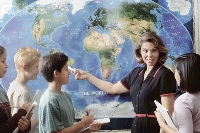
Creative ideas for taking the mystery out of the five themes of geometry
Geography remains the great mystery for many students. Every day kids graduate from high school without a basic grasp of where they are on the planet, which countries are connected, or even the name of some of the biggest countries in the world.
If you’re a teacher or homeschool parent looking for a way to overcome those issues, I have some gathered some effective and affordable ideas. I started with the “Five Themes of Geography,” a framework that helps you organize geographic information so that it’s easy to teach and easier to learn, then added ideas on to teach each one.
Theme One: Location
This is what most people think about about when the word geography is mentioned. But it’s also the hardest for most students to master.
A quick way to boost student learning and retention is to use games to teach geographic locations. There are a number of affordable and effective games out there for all ages.
Map-making is another way to teach location skills. Instead of having students look at printed maps and memorize locations, have them draw and label their own maps. For younger students, start with neighborhood maps, and build out from there. For middle school and high school students, state or province, country and continent maps are the perfect way to encourage a solid grasp of where they are, where other countries are located and how they connect.
Another great idea is to have students look up the the latitude and longitude coordinates of a place where news events have happened. Assign each student to bring in a story, then mark it’s exact location on a large world map.
~
Theme Two: Place
Place is about the physical characteristics of a location. Things like rivers, mountains, and local ecology are all included in this part of the five themes of geography.
As with place, games can be a great teaching tool. One game series in particular stands out in this category. Sim City and Sim Earth are computer simulation games that let players design their own locations, complete with terrain, water features and (in the case of Sim Earth) climate.
Another idea is to have students work in teams to create travel brochures or postcards for an assigned location. But they are not allowed to write the name of the location. Instead, they should describe and illustrate the location via it’s natural features, proximity to other locations, food, culture and other aspects of place that could act as clues.
Then have the other students (or teams) try to guess the locations of the other brochures or postcards.
Theme Three: Human Interaction
As people interact with their location, they affect the geography. This aspect of the five themes encourages students to understand how this happens, and what the effects could be.
I found a wonderful website with creative ideas for dealing with this theme in the classroom, including a historical perspective on your current town, creating lists of current events and how they affect the area, and looking at the impact of human interaction in one area on life in other parts of the globe.
Theme Four: Movement and Migration
As people move from town to town, or country to country, they change the geography. But this can be challenging for students to understand.
One of the best ways to understand this concept is to have students look at the history of their own families. Have them identify one country where their ancestors used to live and when (approximately they came to the U.S. or Canada.
Have them research (or speculate on) the impact of the move on the old location and the new one in terms of land use, water use, occupations, education and religion.
Theme Five: Regions
This is probably the hardest of the five themes of geography when it comes to pinning it down to a definition. That’s because a region can be an identifiable boarder, like a state or country, or it can be an concept, like “The South.” It can even be as a small as a school district or the reach of a daily newspaper.
One creative way to teach the concept of regions is to have students create a map of an imaginary world. Make sure each map includes at least three continents, with at least two countries on each. Have the students name some cities and towns, too.
Once the maps are created, give each student a sheet of transparency paper and a marker. Have then identify three small regions, three large regions, a region that follows an already existing border, and a region that crosses borders. Talk about the impact of these regions on life in their imaginary world (i.e., passports, raw materials, immigration, etc.)
